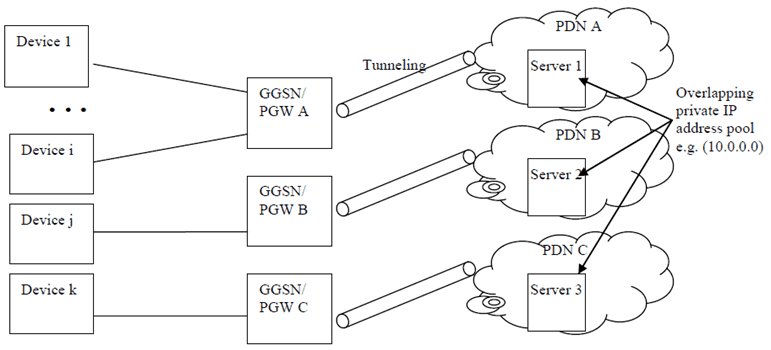Content for TS 23.221 Word version: 18.0.0
B Guidance related to IPv4 address usage |R11| p. 51
B.1 General p. 51
3GPP has investigated and documented various aspects of interworking as well as transition mechanisms related to IPv6 address usage and coexistence with IPv4 environment. These guidelines are as well applicable for usage in environment like MTC as deemed appropriate.
- For general guidelines towards IPv6 migration aspects, TR 23.975, "IPv6 migration Guidelines" should be followed as appropriate.
- For Session based applications similar to IMS, TR 23.981, "Interworking aspects and migration scenarios for IPv4-based IP Multimedia Subsystem (IMS) implementations" may be used as appropriate. The report describes baseline guidelines and in conjunction with TS 23.228 provides comprehensive details for coexistence/transition/migration for IPv6 and IPv4 addressing in 3GPP networks for IMS.
B.2 Interworking aspects p. 51
B.2.1 Interworking scenario: UE assigned private IPv4 address p. 51
When IPv4 addressing is used, the UE, for example in case of MTC, is normally assigned a private IPv4 address due to the limitation of the public IPv4 address space. In case of MTC, the MTC Server may reside in the same private IPv4 address space as the UE, or the MTC Server may reside in public IPv4 address space. In the first case, the UE used for MTC and the MTC Server are in the same routable address space. In the latter case, the UE used for MTC and the MTC Server are located in different private IP address spaces.

Figure B.2.1-1: Application Server (e.g. MTC) in a public or private address space and UE in private address space
(⇒ copy of original 3GPP image)
(⇒ copy of original 3GPP image)
B.2.2 Use of Device triggering p. 51
For indirect and hybrid model, use of device triggering as described in TS 23.682 may be used to handle NAT traversal in situations where the Server (e.g. MTC Server) or Application is attempting to communicate with UEs in a private IP address space. In addition device triggering may be used to get the device to initiate the communication with the Server or Application.
B.2.3 Specific APN use p. 52
For indirect and direct model (as described in TS 23.682), use of separate explicit Access Point Names (APN), and IPv4 address allocation performed following procedures as described in 3GPP specifications in TS 23.401 and TS 23.060 and TS 29.061 resolves private IPv4 address usage issues.

Figure B.2.3-1: Example IP address assignment when the Server is owned by the MNO or by Application Provider using specific APNs
(⇒ copy of original 3GPP image)
(⇒ copy of original 3GPP image)
In case of MTC, the Server is either deployed by the PLMN operator or by an application provider who owns an MTC Server and uses a specific APN assigned by the PLMN. In both cases a tunnelling mechanism is used between the GGSN/P-GW and the PDN of the Server to allow carrying the IP packets enabling assignment of private IP addresses to the UE used for MTC. The tunnelling allows for connecting the PLMN with the Server(s) using public IP networks. Furthermore that tunnelling allows for setting up private network with multiple GGSNs/P-GWs and multiple Servers where every GGSN, P-GW or the Server can be deployed at a different location. By using a separate APN per application (provider) the Servers from different applications can use the same overlapping private IP addresses as needed without the need for the network to implement a NAT function as the UE used for MTC and servers used for MTC belonging to one application share the same private IP address space.